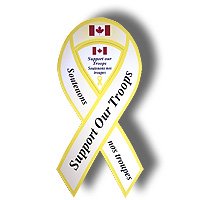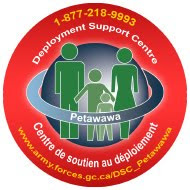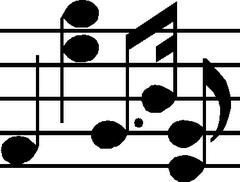
Maj. Yves LeBlanc, a CP-140 Aurora pilot, holds his two-year-old son Jeremy after returning from Operation Mobile, Canada's military contribution to the crisis in Libya, in Greenwood, N.S. on Saturday, Nov. 5, 2011.
 Canadian Forces members are returning to Canada after a successful operation in the skies over Libya and the Central Mediterranean. Canada took a leading role in the UN-mandated, NATO-led Operation to protect the people of Libya from the former Gaddafi regime while also imposing an arms embargo and a no-fly zone."Canada once again punched above its weight as part of an international coalition. The men and women of the Canadian Forces confirmed their leadership position at NATO and the role they can play in successful international operations," said the Honourable Peter MacKay, Minister of National Defence. (Photo Credit: Cpl Marc-André Gaudreault)
Canadian Forces members are returning to Canada after a successful operation in the skies over Libya and the Central Mediterranean. Canada took a leading role in the UN-mandated, NATO-led Operation to protect the people of Libya from the former Gaddafi regime while also imposing an arms embargo and a no-fly zone."Canada once again punched above its weight as part of an international coalition. The men and women of the Canadian Forces confirmed their leadership position at NATO and the role they can play in successful international operations," said the Honourable Peter MacKay, Minister of National Defence. (Photo Credit: Cpl Marc-André Gaudreault) "I am extremely proud of the men and women of the Royal Canadian Air Force and Royal Canadian Navy whose contribution was, without a doubt, instrumental in the protection of civilians from the violence of the Gaddafi regime."Canada responded rapidly and strongly after the passage of U.N. Security Council Resolution 1973 of March 17, 2011. In less than 24 hours, CF-18s were airborne from 3 Wing Bagotville enroute to their operating base in Trapani, Italy, along with strategic air-to-air refuelling support from 8 Wing Trenton's Polaris aircraft. 8 Wing's CC-177 Globemasters followed immediately with all personnel and equipment needed to quickly establish an effective operational capability."Throughout this deployment, our airmen and airwomen demonstrated their outstanding skills and agility in successfully conducting air-to-air integrated operations with our NATO Allies, flying side-by-side conducting surveillance and bombing missions, providing air refueling to coalition aircraft, and patrolling the shore of Libya," said Lieutenant-General Andre Deschamps, the Commander of the Royal Canadian Air Force. "Their professionalism and dedication played a significant role in the protection of innocent civilians against an oppressive regime, and it is with pleasure that we welcome them home after a job well-done."The deployment of Canadian assets to the region, including a frigate, CF-188 Hornet fighters, CC-150 Polaris in-flight refuelling tankers, CC-130 Hercules tankers, and CP-140 Aurora maritime patrol aircraft - gave Canada and the Canadian Forces the flexibility and capability to respond to the ongoing crisis in the region by providing critical aviation support to coalition efforts.The CF-18 aircraft conducted 946 sorties, making up ten percent of NATO strike sorties. Over the course of their sorties, Canada's fighters dropped 696 bombs of various types.The two CC-150T and one CC-130T aircraft deployed flew 389 air-to-air refueling sorties. They dispensed a total of 18,535,572 lbs of fuel to aircraft from six nations involved in Operation UNIFIED PROTECTOR - France, Italy, the United Arab Emirates, the United Kingdom, the United States, and Qatar.The two CP-140 aircraft deployed on Operation MOBILE flew 181 sorties off the coast of Libya and over land. They conducted Intelligence, Surveillance and Reconnaissance (ISR) sorties, as well as strike coordination and armed reconnaissance-coordinator sorties that provided critical information and helped the NATO effort to protect civilians.
*As directed by the Government of Canada, Operation MOBILE (Canada's military response to the crisis in Libya) has ceased operations and commenced mission closure activities as of 1 November, 2011.*http://www.comfec-cefcom.forces.gc.ca/pa-ap/ops/mobile/index-eng.asp



























No comments:
Post a Comment